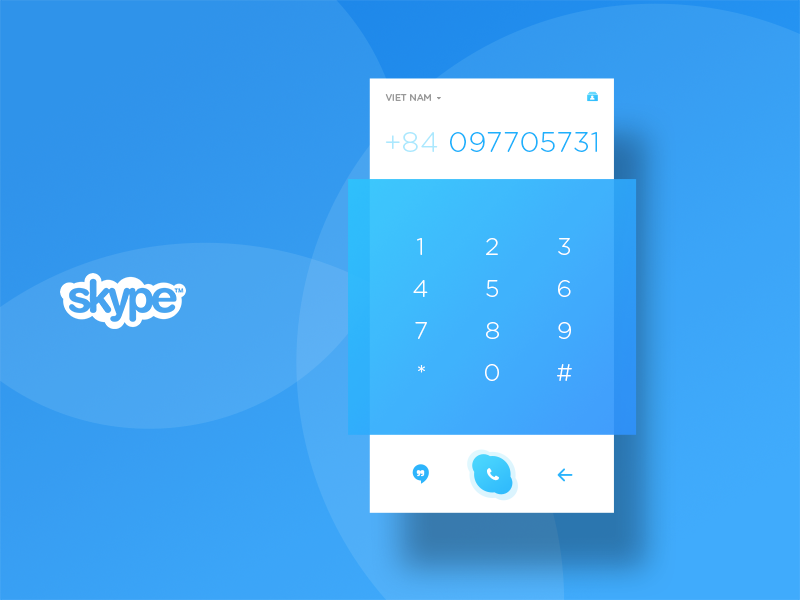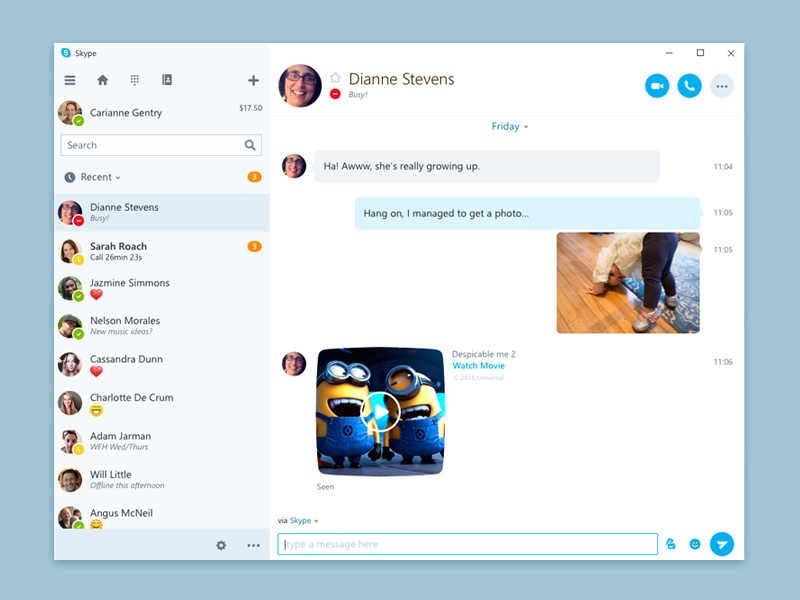One More Skype Concept For Mac
Hello Biplab, Thanks for posting here. From your description, it may be related to the corrupted issue.
I will send you a private message to share with you a way to totally remove the Skype for Business on Mac client and then you can reinstall it to check it. You can open your community profile and then click View private message to access it. Meanwhile, if issue persists, please disconnect all e xternal hard devices with your Mac to check this issue again. Hope the above information helpful. Regards, Rudy.
Hello Biplab, Thanks for your reply. Have you check if you disconnect all external hard devices as I mentioned above? If not, please do it and let us know how it goes. Please update all hard device driver to the latest one to check it.
Meanwhile, does the Skype for Business occur any exception when you normally use it? Like it fails to join a skype meeting, you can't send the I M s or the presence status shows incorrectly and so on. Regards, Rudy Hello Rudy, I'm not sure if I understand what you mean by disconnect external hard devices. Yes, there are no external hard drives connected to my Mac and there are no software/driver updates pending as well. Hope that answers your question. Thanks and regards, Biplab. Hello BipLab, Thanks for your reply.
Your understand is correct and I know there is no third party hard devices (like audio and video device, keyboard, mouse and so on) to connect with your Mac. Also, from your post, the memory leak issue occurs when you login to Skype for Business client and then you don't do any operation.
Please correct me if anything is misunderstanding. In this situation, we'd like to collect the Sample logs for further checking:. Open Activity Monitor Memory tab, then make sure Skype for Business is running with Memory leak (Or reproduce the issue). Double-click Skype for Business click Sample button.
After finishing the Sample logs collection, please upload the log files in private message. We appreciate your time. Regards, Rudy.
Hello BipLab, Thanks for your reply. Your understand is correct and I know there is no third party hard devices (like audio and video device, keyboard, mouse and so on) to connect with your Mac. Also, from your post, the memory leak issue occurs when you login to Skype for Business client and then you don't do any operation.

Please correct me if anything is misunderstanding. In this situation, we'd like to collect the Sample logs for further checking:. Open Activity Monitor Memory tab, then make sure Skype for Business is running with Memory leak (Or reproduce the issue).
Double-click Skype for Business click Sample button. After finishing the Sample logs collection, please upload the log files in private message.
We appreciate your time. Regards, Rudy Hello Rudy, Yes all third party hard devices are disconnected from the Mac. Also I don't do any operation on the Skype for business client. Provided you with the logs that you had asked for. Thanks and Regards, Biplab.
Free Skype For Mac
This is sort of a long question about the Skype client and using DNS load balancing on our deployment. Quick background for you guys.
We use three FE servers in the LAN with 2 edge servers and a reverse proxy in the DMZ. The edge servers and reverse proxy each have one public IP address (consolidated services, ie sip.domain.com covers sip, av, and webconf all use the same public IP address on each server).
The reverse proxy is a Big IP F5 and is the only part of the deployment using hardware load balancing as the documentation states that DNS load balancing can be used for everything except the web services which still require hardware load balancing. We have DNS set up to point all internal and external users 100% through the edge/reverse proxy services via their public IP addresses because all of our sites use IPSec VPN tunnels to connect to each other so pointing everyone externally keeps the jitter down that would otherwise be caused by the VPN tunnels (in other words the traffic travels outside of the VPN tunnels so that the encryption/decryption doesn't cause extra latency. Nothing ever connects directly to the FE as far as clients go). At least this is what we believe should be happening which brings me to my question. As stated, we have sip.domain.com, lyncdiscover.domain.com, webexternal.domain.com, dialin.domain.com, schedule.domain.com, meet.domain.com all pointing to the public IP addresses of their edge/reverse proxy services (sip.domain.com has two entries with two different addresses for the sake of DNS load balancing). Lyncdiscoverinternal has been completely removed from all records to force all clients to use the external autodiscover record.
The internal pool fqdn, which is also the internal web services fqdn, still exists and points to the internal pool member internal IP's. This is because we were hesitant to override the internal web services fqdn and we were hesitant to remove the internal pool host entries from DNS because we just assumed with the clients always getting external autodiscover record they would always just reach out to all of the external services, including going straight to webexternal.domain.com. Long story short, how does a client determine if it is internal or external (specifically in relation to the web services URL it chooses)? Does it poll AD to determine if it is part of a subnet recognized as an AD site? Does it determine if it is external based off of using the external autodiscover record?
Or does it make the determination based off of whether it is connected to an edge server vs a FE server as documented in the Inside User Status found here: This deployment has been running beautifully since we put it into production 6 weeks ago and I have not seen a single ticket regarding Skype whatsoever which makes me feel like this is all set up properly. But I want to make sure that everything is pointing in the right direction here and no surprises are coming down the road.
The client get the configuration with the first connection to his FE pool. To find the pool, the client will try to use Lyncdiscover.sip.domain first.

If the client is connected, the client will get his mras credential for the edge server. If the client send or get a invite, the invite contain the ICE candidates for the media connection an try to reach the other client direct.
If this is not possible, the client try to reach the client through the edge server. Because of the used IP addresses, the client know which IP is internal or external through the Edge server an can reach the other client. If this is not working, the Edge is mostly misconfigured (routing, certificates etc.) or the Firewall, Router. This is only a short description. Regards Holger Technical Specialist UC.
So from the above, it would sound to me that even though my clients are internal, since everyone is always pointed to the edge servers the clients should always be skipping the internal web services URL and going straight to the external URL. It was stated that the Edge servers would then always be giving my clients the configuration information, so does that mean that the edge servers know to tell my clients to go to webexternal.domain.com always, or could clients on the internal LAN still potentially be pointed to the internal pool fqdn? What I am getting at is, if they go externally as intended, they will be hitting the revers proxy/load balancer and all will be proper. If they are going internally to the internal web services FQDN, they are hitting a series of round robin entries pointing individually to my FE's which I know is not supported for the web services. I need to know if i need to adjust the internal web services fqdn while leaving the actual pool fqdn the same, or if I can know for sure that clients are not going to ever try to connect the internal web services fqdn.
Same story as stated above just a different version Had come across a scenario once where customer had his own reasons to publish FE over internet, please don't ask me why. Considering the scenario, Based on the published internal or external website client would get the web Service URL's accordingly. When we look at auto discover record its an HTTP/HTTPS client - which is not handled by Edge (other than Media). Frontend would provide the URL's based on which Website on frontend clients connects to (internal 443 or External 4443), irrespective of the DNS used to connect to the registrar based on which its determined if client is internal (true) or External (False) with help of the network routes. As we have seen lot of issues where the DNS request been routed externally for an internal client, which will cause the client to make all queries external and might fail to connect to few of the web services which wont be allowed from inside the network.
One More Skype Concept For Macbook Pro
So we can state because of where the client resides it will use the Web Service URL's accordingly. You can place the client any where until you are able to suffice the client required services with approval from Security team.